Where Do Rhinos Live?
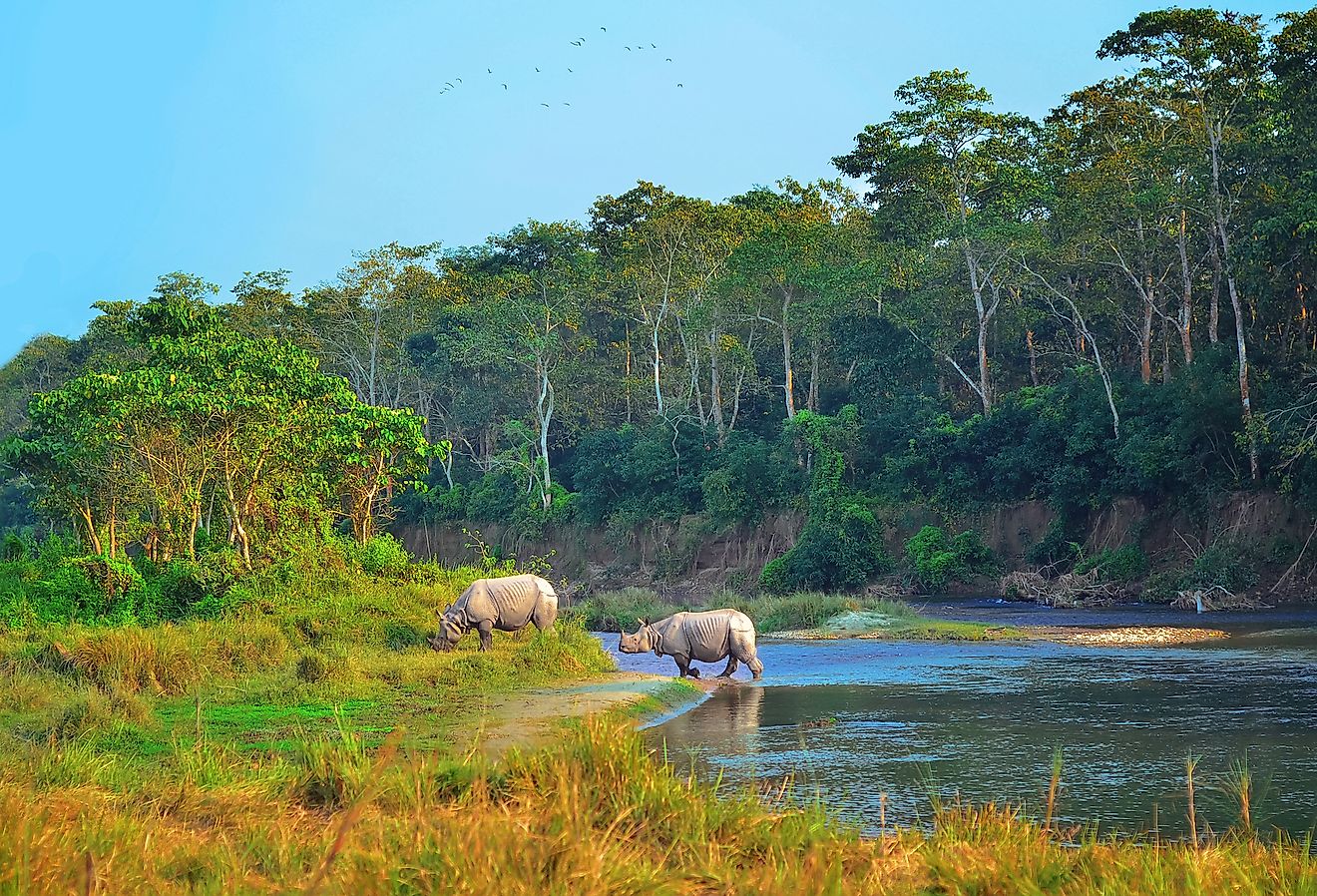
- Four out of the five rhino species are endangered, and one subspecies is extinct in the wild.
- The Javan rhino was once widespread over large parts of Southeast Asia but is now only found in Java, Indonesia.
- Around 99% of southern white rhinos live in South Africa, Namibia, Zimbabwe, and Kenya.
Rhinos were once widespread throughout Europe, Asia, and Africa, with around 500,000 individuals at the start of the 20th century. By the 1970s, their numbers dropped to 70,000. Today, there are only about 27,000 rhinos. Poaching for their horns has been the biggest cause of their steep population decline. All but one of the five rhino species are endangered, and one rhino subspecies was declared extinct in the wild.
The five rhino species, their range, habitat, and threats are described below:
Sumatran Rhino
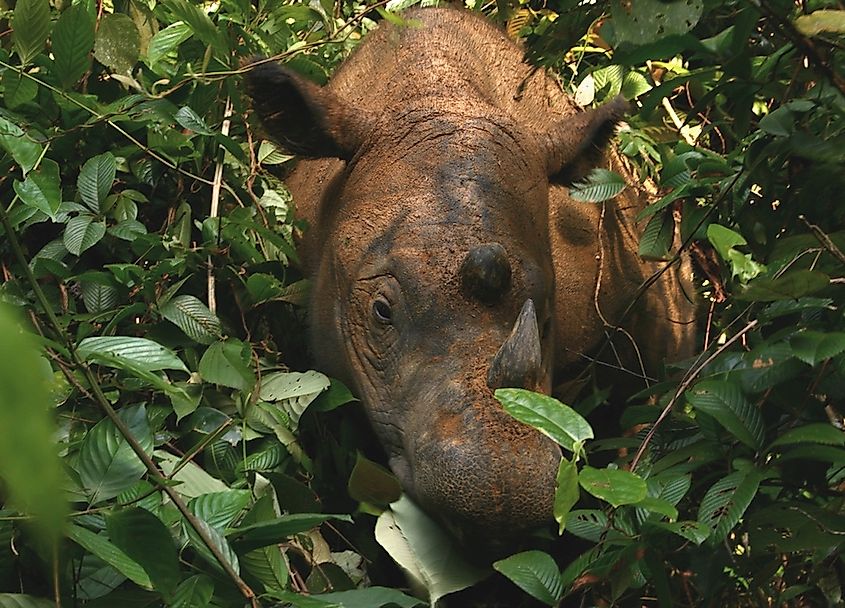
The two-horned Sumatran rhino (Dicerorhinus sumatrensis) is the oldest of the five rhino species. Since 1996, it has been listed as critically endangered by the International Union for Conservation of Nature (IUCN). The Sumatran rhino population has lost more than 80% of its population since the 1930s.
Range
The Sumatran rhinos were once widespread across Southeast Asia, Bhutan, the Himalayas, India, Myanmar, China, Cambodia, the Malay Peninsula, Indonesia, and Thailand. However, they are now only found in a few sites in Sumatra and Borneo in Indonesia. The last living Sumatran rhino in Borneo, Malaysia, died in 2019.
There are currently no more than 80 individual Sumatran rhinos living around Borneo and Sumatra. Most of the remaining subpopulations are too small to be viable long-term breeding populations.
Habitat
Sumatran rhinos live in dense highland and lowland tropical forests, marshy areas, mountainous country, and places with thick bush and bamboo.
Threats
Over the past 20 years, more than 70% of the Sumatran rhino numbers have decreased, and they are considered extinct in Malaysia. The illegal wildlife trade is one of the biggest threats to the Sumatran rhino population. Their horns are highly desired in Asia, the Middle East, and North Africa. In Asia, particularly in China and Vietnam, rhino horn has long been used in traditional medicine for its supposed medicinal qualities. This demand for rhino horns has increased poaching across Africa and Asia.
Habitat loss and fragmentation have also contributed to the Sumatran rhinos' decreasing numbers. These animals live in small, fragmented populations where they do not have many opportunities to find each other and breed. The causes of their habitat loss include invasive species, road construction, and encroachment of agricultural expansion.
Javan Rhino
Javan rhinos, also known as lesser one-horned rhinos, are one of three Asian species of rhinos. They are critically endangered and are the most threatened of the five rhino species. There are now only around 60 individuals living in one location in Indonesia.
Range
The Javan rhino (Rhinoceros sondaicus) was once common over a large part of Southeast Asia, from India to Bangladesh, China, Laos, Vietnam, Myanmar, Cambodia, Thailand, Malaysia peninsula, Sumatra, Borneo, and the western half of Java. However, the Javan rhino numbers had the steepest decline of all three Asian rhino species. By the 1930s, they were restricted to Ujung Kulon, a small peninsula on the westernmost tip of Java, and isolated populations in Vietnam, Laos, and Cambodia. The last Javan rhino in Vietnam was poached in 2010.
Currently, Javan rhinos are only found in a single population in the Ujung Kulon National Park in Java, Indonesia, with around 60 individuals. The national park is believed to have reached its carrying capacity, and if the rhino population is lost, the entire species will become extinct.

Habitat
Javan rhinos used to live in many different lowlands and highland tropical landscapes. The rhinos had a broad ecological range, from India's mangroves to the sub-montane shrubs on Java's volcanoes. The Ujung Kulon National Park provides the rhinos with ideal habitat conditions, such as forests interspersed with glades. They also inhabit marshy areas and areas with thick bush and bamboo.
Threats
One of the biggest threats to the Javan rhino is inbreeding from having a small population living in one location. This situation can lead to loss of genetic variability. Although their habitat is secure, it is not sustainable for their long-term survival. Other threats to their populations are poaching, habitat degradation, diseases, and natural disasters.
The national park where the Javan rhinos live is highly vulnerable to tsunamis. A volcanic eruption of the nearby Anak Krakatau volcano could wipe out many rhinos in the protected area. Rising sea levels due to climate change could also threaten the park.
Greater One-Horned Rhino
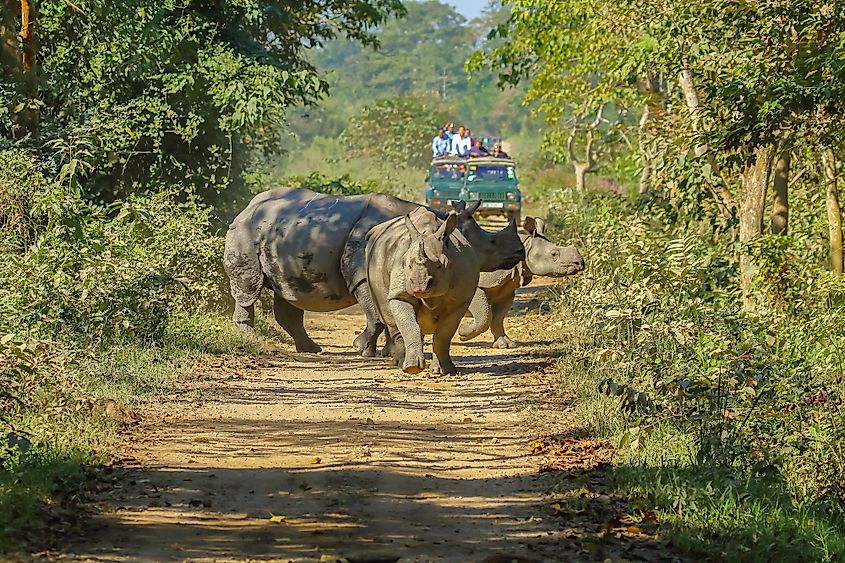
The greater one-horned rhino (Rhinoceros unicornis), also known as the Indian rhino, is the largest rhino species. They are considered vulnerable to extinction and have a population of around 3,700 individuals.
Range
Greater one-horned rhinos were once widespread across India, Pakistan, Bangladesh, Nepal, and Myanmar. However, in the early 19th century, the animals were almost hunted to extinction for sport and killed as agricultural pests. As a result, only around 200 wild greater one-horned rhinos remained. Fortunately, the rhino's population bounced back from under 200 to approximately 3,600 due to strict protection from Indian and Nepalese wildlife authorities. Today, they live in about 11 reserves in Bhutan, northeastern India, and at the foothills of the Himalayas in Nepal.
Habitat
Greater one-horned rhinos live in tropical and subtropical grasslands, deserts, savannas, and shrublands. They are also semi-aquatic animals and live in swamps, forests, riversides, or areas close to mineral licks.
Threats
Much like many of the rhino species, the biggest threat to greater one-horned rhinos is poaching. While anti-poaching efforts have contributed to their population increases, the demand for their horn remains high, and illegal trade persists throughout Asia.
Habitat loss is also threatening the greater one-horned rhino's populations. The disappearance of plain alluvial grasslands resulted in a massive reduction in the rhinos' range. Human-animal conflict is increasing due to humans encroaching onto lands where rhinos live. As a result, rhinos frequently leave the boundaries of protected areas to find food near surrounding villages.
Black Rhino
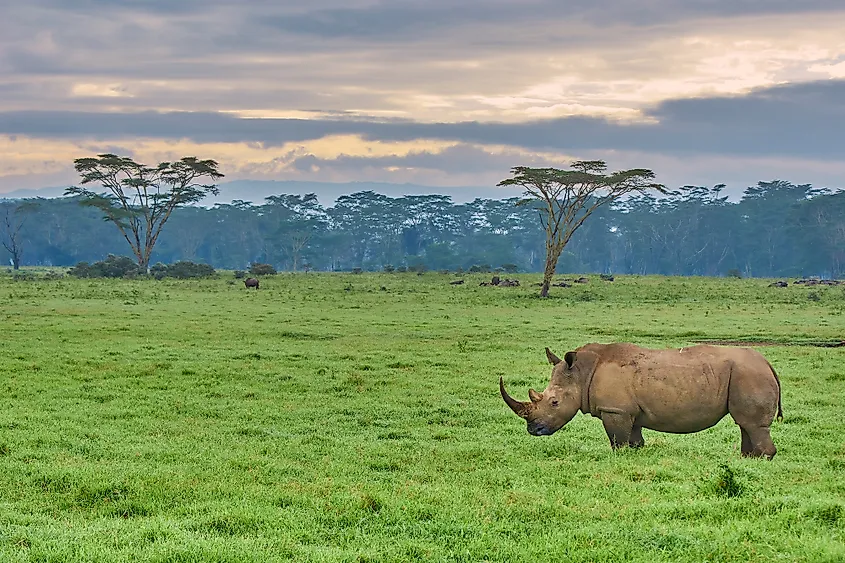
There are four subspecies of black rhinos: the Southern Central black rhino, the South Western black rhino, the Eastern black rhino, and Western black rhino. Black rhinos are the smallest African rhino species. They are critically endangered and have a population of around 5,600.
Range
Black rhinos (Diceros bicornis) roamed across Africa, from South Africa to Angola, Somalia, Ethiopia, and Sudan. They also lived in northern Cameroon, Nigeria, Burkina Faso, Côte d'Ivoire, and Guinea. Around the 1900s, black rhino populations were abundant and estimated to be more than 1 million. Rampant poaching by European hunters and settlers reduced their numbers, and from 1960 to 1995, their population dropped by 90% to around 2,400.
Black rhinos are found in scattered populations in Botswana, Kenya, Malawi, Namibia, South Africa, Swaziland, Tanzania, Zambia, and Zimbabwe. Many live in well-guarded parks and reserves. South Africa and Namibia have the most black rhino populations.
Habitat
Black rhinos live in tropical and subtropical grasslands, savannas, shrublands, deserts, and xeric shrublands. Their habitats are varied, and they can also live in mountain forests and moorlands at high altitudes.
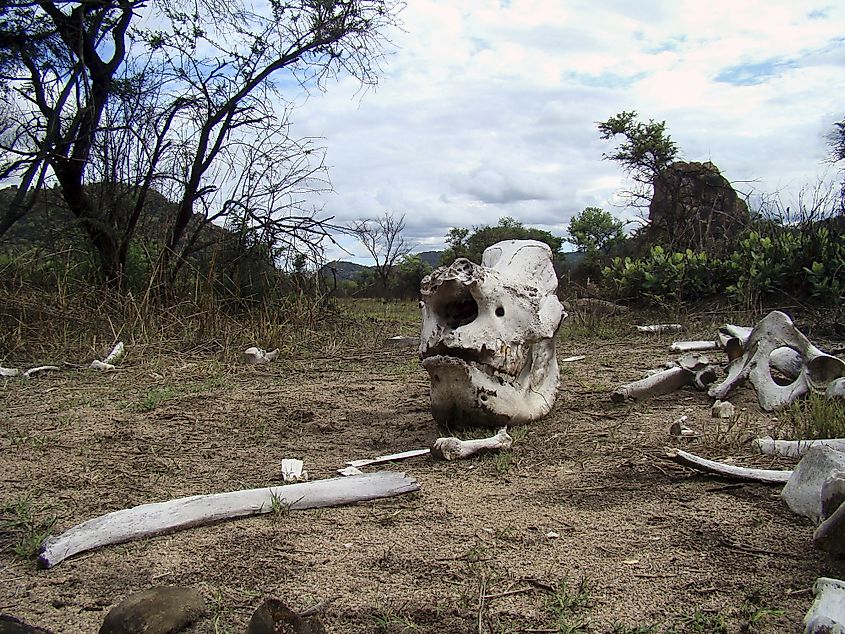
Threats
The biggest threat to the black rhino populations is poaching. In 2014 alone, over 1,200 rhinos were poached due to rising demand for their horns in traditional Asian medicines. While conservation efforts have protected some of the remaining black rhinos from poachers, poaching has increased in parts of Africa. For example, political instability and wars have hindered rhino conservation in Angola, Rwanda, Somalia, and Sudan.
Other threats to their population are inbreeding among smaller, isolated communities and disease transmission.
White Rhino
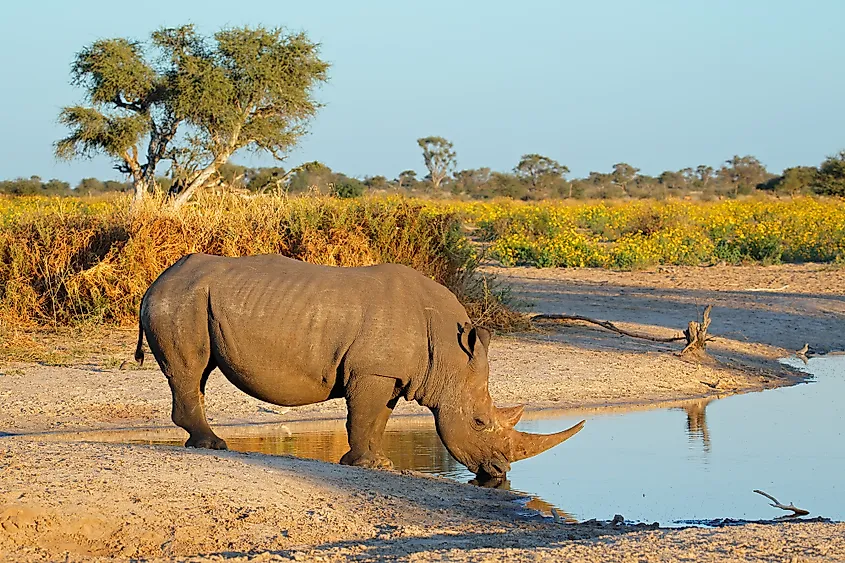
There are two subspecies of white rhino: the Southern and Northern rhino. In total, white rhinos have over 19,000 individuals, but there are only two remaining northern white rhinos, both related females, and the last male northern white rhino died in 2018. White rhinos are classified as near threatened, the only one of the five rhino species not endangered.
Range
White rhinos (Ceratotherium simum) live in South Africa, Botswana, Kenya, Namibia, Swaziland, Zambia, Zimbabwe, and Uganda. The northern white rhinos live in the Ol Pejeta Conservancy in Kenya, and armed guards protect the rhinos 24/7. But the subspecies once roamed in South Sudan, Uganda, the Democratic Republic of Congo, and the Central African Republic.
Around 99% of southern white rhinos live in South Africa, Namibia, Zimbabwe, and Kenya. Their populations declined to less than 100 by the end of the 1800s. After more than a century of protection, their numbers bounced back to over 19,000.
Habitat
White rhinos live in African long and short grass savanna areas, grassy plains, and prefer tropical and subtropical grasslands and shrublands.
Threats
White rhinos neared extinction in the late 19th century due to rampant poaching for their horns. Today, they still face poaching threats due to the same reasons why the other rhino species are hunted for their horns. White rhinos are particularly vulnerable because they are less aggressive and live in herds.
While the southern white rhino population is in the thousands, the northern white rhino is critically endangered. They were declared extinct in the wild in 2008.
Rhinos once lived over a large area in Asia and Africa. But poaching was, and still is, one of the biggest threats to all rhino species, and it is why their populations drastically declined in many countries. Fortunately, conservation efforts in India and Africa have brought some rhino species back from the brink of extinction.











